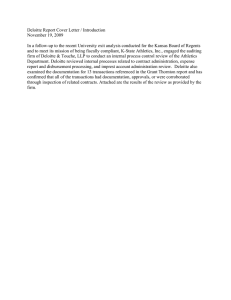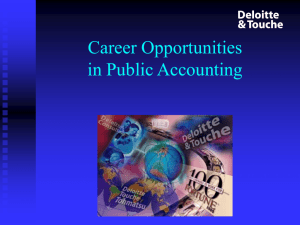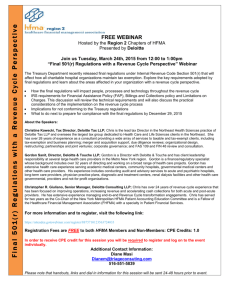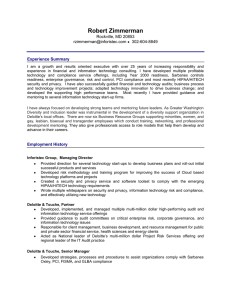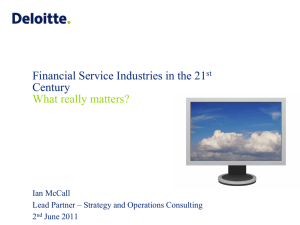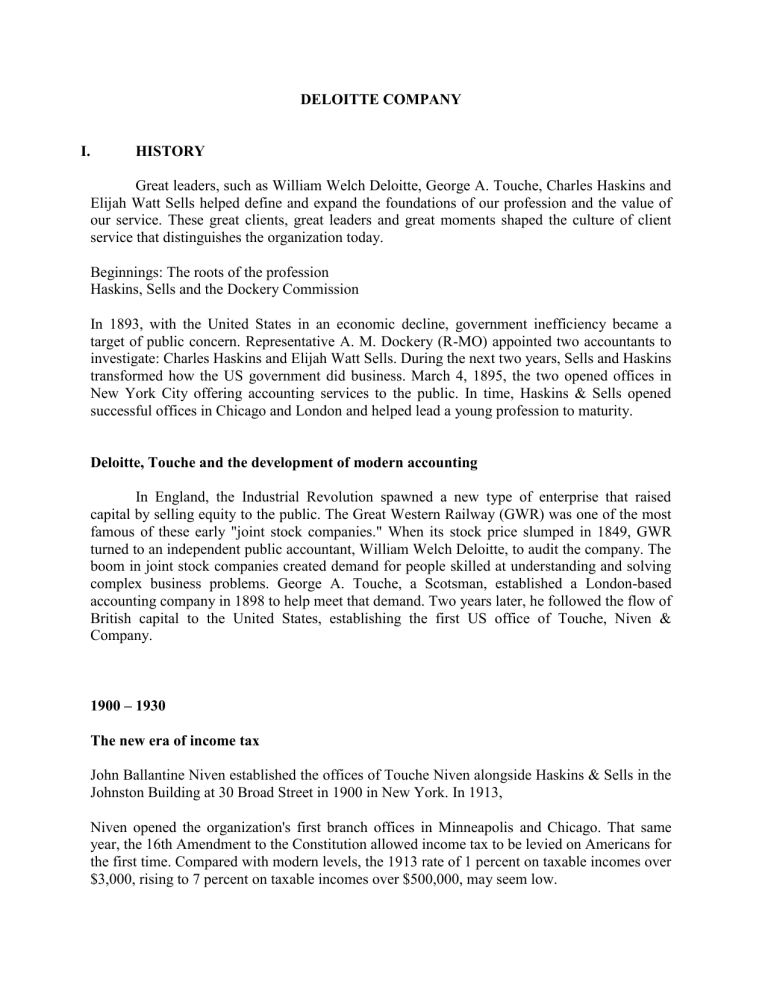
DELOITTE COMPANY I. HISTORY Great leaders, such as William Welch Deloitte, George A. Touche, Charles Haskins and Elijah Watt Sells helped define and expand the foundations of our profession and the value of our service. These great clients, great leaders and great moments shaped the culture of client service that distinguishes the organization today. Beginnings: The roots of the profession Haskins, Sells and the Dockery Commission In 1893, with the United States in an economic decline, government inefficiency became a target of public concern. Representative A. M. Dockery (R-MO) appointed two accountants to investigate: Charles Haskins and Elijah Watt Sells. During the next two years, Sells and Haskins transformed how the US government did business. March 4, 1895, the two opened offices in New York City offering accounting services to the public. In time, Haskins & Sells opened successful offices in Chicago and London and helped lead a young profession to maturity. Deloitte, Touche and the development of modern accounting In England, the Industrial Revolution spawned a new type of enterprise that raised capital by selling equity to the public. The Great Western Railway (GWR) was one of the most famous of these early "joint stock companies." When its stock price slumped in 1849, GWR turned to an independent public accountant, William Welch Deloitte, to audit the company. The boom in joint stock companies created demand for people skilled at understanding and solving complex business problems. George A. Touche, a Scotsman, established a London-based accounting company in 1898 to help meet that demand. Two years later, he followed the flow of British capital to the United States, establishing the first US office of Touche, Niven & Company. 1900 – 1930 The new era of income tax John Ballantine Niven established the offices of Touche Niven alongside Haskins & Sells in the Johnston Building at 30 Broad Street in 1900 in New York. In 1913, Niven opened the organization's first branch offices in Minneapolis and Chicago. That same year, the 16th Amendment to the Constitution allowed income tax to be levied on Americans for the first time. Compared with modern levels, the 1913 rate of 1 percent on taxable incomes over $3,000, rising to 7 percent on taxable incomes over $500,000, may seem low. 1930 – 1950 After the crash: Audits and regulations “Free, fair and full reports of industrial organizations,” the January 12, 1901, issue of Commerce, Accounts & Finance said, “should be founded upon thorough, independent audits of accounts by disinterested certified public accountants, whose signed certificates, to be published with the report, are a more nearly perfect guarantee of reliability than any other yet to be discovered.” This article that been written by Charles Haskins were largely ignored by Washington and Wall Street regulators. The stock market crash of 1929 and the ensuing Depression brought the issue into the public spotlight, especially when it became obvious that proper accounting practices might have prevented some bankruptcies and consequent unemployment. On April 1, 1933, Colonel Arthur Carter, President of the New York State Society of CPAs, testified before the US Senate Committee on Banking and Currency. Carter helped convince Congress that independent audits should be mandatory for public corporations. A year later, the Securities and Exchange Commission was created to administer the new legislation. The regulating bodies immediately needed accountants. Women accountants, who (except for the remarkable Jennie Palen) had been unable to make headway at the leading firms, suddenly found themselves in demand. 1950 – 1970 Postwar growth After World War II America stood on the brink of historic economic expansion. In 1947, Detroit accountant George Bailey, then president of the AICPA, launched his own organization. The new entity enjoyed such a positive start that in less than a year, the partners merged with Touche Niven and A.R. Smart to form Touche, Niven, Bailey & Smart. Headed by Bailey, the organization grew rapidly, in part by creating a dedicated Management Consulting (MC) function. It also forged closer links with organizations established by the cofounder of Touche Niven, George Touche: the Canadian organization Ross, Touche and the British organization George A. Touche. In 1960, the organization was renamed Touche, Ross, Bailey & Smart, becoming Touche Ross in 1969. John William Queenan joined Haskins & Sells in 1936. As managing partner from 1956 until his retirement in 1970, he led the organization through major developments in the profession. Haskins & Sells experienced its own major development by merging with 26 domestic organizations and establishing offices in Canada, Central and South America, Europe, and Japan. Leading the information revolution In the 1950s, information technologies became increasingly important in business. Few professions were affected more than accounting. Data processing machines freed accountants to focus on developing and monitoring systems to improve the way clients managed. Touche Ross led the profession into this uncharted territory. In 1952, it became the first large accounting organization to automate its bookkeeping. Later, Gordon Stubbs wrote Data Processing by Electronics and Introduction to Data Processing, the first two professional brochures of their kind. In 1964, the organization's work with statistical sampling led to the Auditape System, which brought computer technology to audits. 1970 – 1990 The 1980s: A new style of management In the 1980s, Deloitte & Touche led the profession through a decade of unprecedented merger and acquisition activity in American business. Emerson’s Professional Services Review commented, “When it comes to acquisition services, no one rivals the Deloitte & Touche infrastructure, commitment, expertise or reputation. The organization's proficiency in mergers and acquisitions emerged in the 1970s when a new style of management became prominent in corporate America. The new managers were financially sophisticated and aware of the synergies and economies of scale offered by mergers and acquisitions. They relied on their accountants for more than audit and tax skills, and looked for insightful advice, technological expertise, global operations and support for their merger and acquisition activity. Accountants began to emphasize their abilities as business consultants offering the full range of accounting services and actively seeking additional ways to help their clients. A new generation of leaders rose to the top of Touche Ross and Deloitte Haskins Sells during these years. As the rate of mergers and acquisitions accelerated, corporate America became increasingly globalized. Corporations increasingly sought advisers skilled in all areas of accounting and proficient at solving problems throughout the world. The newly formed Deloitte & Touche was led by J. Michael Cook and Edward A. Kangas, who shared the belief that successful accountants of the future would combine strong professional abilities with a deep understanding of their clients’ industries, situations and needs. 1990 – 2000 Competing for the future Deloitte & Touche set out to provide the coordinated, global services and solutions our clients required. The organization needed more than technological sophistication and knowledge of international business. It needed, as managing partner James E. Copeland, Jr., pointed out in 1994, the intellectual equivalent of systems integration the ability to combine competencies from all functional disciplines across national borders to create solutions for clients. To achieve our goals, we had to hire high-caliber recruits in every country, and then train them to excel. We had to maintain the highest ethical standards in the world. We had to be, in the words of the firm’s powerful mission statement, “the professional services firm that consistently exceeds the expectations of our clients and our people.” In 1995, the partners of Deloitte & Touche voted to create Deloitte Consulting to better serve our multinational clients. As Haskins noted more than 100 years ago, our “study and interest is the soundness of the world of affairs.” Our goal continues to be to “simplify work so that it can be done more rapidly and more effectively.” 2000 - present Between 2003 and 2005, Deloitte LLP reorganized its businesses to better align itself with the manner in which business is conducted. It currently has the following four subsidiaries that provide client services: Deloitte & Touche LLP, Deloitte Consulting LLP, Deloitte Financial Advisory Services LLP and Deloitte Tax LLP. As The Deloitte US Firms move forward, they continue to establish themselves as the employers of choice in their professions. The Deloitte US Firms have a unique internal environment that allows the organization to deliver high quality services to today's leading companies and tomorrow's.
